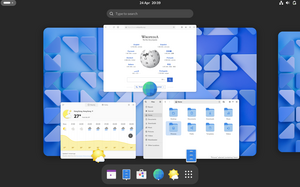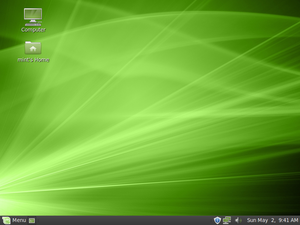Some random pickings...
- In summary, it looks as if Open Office is continuing on its path as the would-be Microsoft Office killer.
- The interface is blissfully simple, emulating Microsoft Office 2000. It's a good counter to Microsoft's 2007 ribbon interface, which buries a lot of the formerly easily accessible toolbar functions.
- ...remarkably improved Spell Check.
- Overall, though OpenOffice.org 3 looks like the best version yet.
--http://www.crn.com/software/211200503
- Users report OpenOffice.org 3.0 has introduced a new graphical and text-based hybrid equation editor, a mail merge wizard, improved label templates and better interface for outlining. Solver, a spreadsheet add-on for combinatorial optimization problems is included in this version.
- Other enhancements highlighted by enthusiasts include collaborative options that allow multiple users to edit documents at the same time and improved drawing and charting tools. OpenOffice.org 3.0 can now display multiple pages during editing and workbooks up to 1024 columns in each spreadsheet.
--http://en.wikinews.org/wiki/OpenOffice.org_3.0_released_by_Sun_Microsystems
- Nevertheless, some reviewers questioned whether the upgrade was sufficient to be billed as a full upgrade.
- On balance, the new OpenOffice.org release is a step forward, and if they can speed it up a bit, we'll be more than happy.
--http://www.informationweek.com/news/software/enterpriseapps/showArticle.jhtml?articleID=211200491
- Writer (word processing):
o New slider control for zooming which allows multi-page display while editing
o Powerful new multilingual support
o Improved notes capabilities
o Ability to edit wiki documents for the web, in addition to conventional office documents
o Increase in capacity of up to 1024 columns per sheet
o Powerful new equation solver
o New collaboration feature for multiple users
oAbility to cope with poster-size graphics - up to three square meters or 32.3 square feet.
o Fully featured table designer inside a presentation
--http://www.desktoplinux.com/news/NS5116175814.html
- Like that botched launch, OpenOffice 3 represents a missed opportunity.
- ...upgrades arguably should have arrived a year ago--the ability to open files created with Microsoft's Office 2007.
- OpenOffice 3 also feels a little faster than earlier editions, especially in terms of its startup time.
- OpenOffice 3 repeats almost all of the interface failings of its ancestors (not to mention old Microsoft Office versions).
--http://voices.washingtonpost.com/fasterforward/2008/10/openoffice_3_is_here_can_you_t.html
- ...this update is worth it for the improvement in response and load times, if nothing else.
- One useful change involving the landing page is that it now shows up whenever you close a document but don't exit the program.
--http://www.download.com/8301-2007_4-10064886-12.html
- It’s a great suite and they still have something that OpenOffice lacks: Publisher.
- OO.org has been good enough for a long time; the latest release should leave little doubt for any users who had been on the fence.
--http://education.zdnet.com/?p=1895
- When compared directly to Microsoft Office, the one thing OpenOffice 3 does lack is a comparable version of Outlook.
- Power users may find OpenOffice 3.0 lacking some of the complex and deeply embedded features found in rival applications.
--http://www.vnunet.com/vnunet/reviews/2228213/first-look-openoffice-org
- OpenOffice.org doesn't include all of Office's features, but it adds some conveniences that Office can't provide, such as built-in PDF export and a single interface for opening and editing word-processing documents, HTML files, worksheets, presentations, and drawings.
--http://www.pcmag.com/article2/0,2817,2332502,00.asp
- One of the most significant killer features in this release are out-of-the-box import filters for the latest Microsoft Office file formats, enabling OpenOffice 3.0 to read documents saved with Microsoft Office 2007 or 2008 in .docx, .xlsx, .pptx or other new formats.
--http://www.tgdaily.com/content/view/39704/140/
- For its part, Microsoft isn't too worried about OOo 3.0.
--http://www.internetnews.com/software/article.php/3777636/OpenOffice+Hits+30+Can+It+Challenge+Microsoft.htm
- The new version's initial release offers only read-only support for Microsoft Office 2007 file formats including DOCX (Word), XLSX (Excel), and PPTX (PowerPoint), but can convert them into Office 2003 file formats.
--http://www.download.com/8301-2007_4-10064408-12.html
- It's an evolutionary change from 2, not a revolutionary one, and if deployed right it could be yet another nibble out of Microsoft (NSDQ: MSFT)'s big Office cookie. The trick is how to get the word out.
--http://www.informationweek.com/blog/main/archives/2008/10/getting_the_wor.html
- But there's growing evidence that the project may be suffering from virtual arteriosclerosis, and 3.0 may be the last great version of the software.
--http://blogs.computerworld.com/is_version_3_0_the_last_great_version_for_openoffice_org
- Pretty nifty stuff, and it's free - well, that is when you can get on the site and successfully download it.
--http://www.channelregister.co.uk/2008/10/13/openoffice_org_download_website_dead/
- OpenOffice 3.0 even makes it easier for anyone to participate in the new Web 2.0 world without having to learn and master esoteric web languages such as XHTML and MediaWiki, said John McCreesh, OpenOffice.org marketing project lead. "Users can create Web and Wiki documents straight from Writer," he explained.
--http://www.newsfactor.com/news/OpenOffice-3-Supports-Mac/story.xhtml?story_id=032001VRUC1S
- Microsoft has a new problem on its plate with rival Sun Microsystems unveiling Open Office 3.0 ...
--http://www.domain-b.com/companies/companies_s/Sun/20081015_free_alternative.html
- The new version offers some aesthetic enhancements and usability improvements, including a new icon set that makes the user interface cleaner and a convenient slider control for adjusting page zoom.
- This version is an important milestone release and could help boost the program's marketshare, particularly on Mac OS X, where it now provides a much higher level of platform integration. Although OpenOffice.org has not yet reached full parity with Microsoft Office, it is maturing at a rapid pace and is already capable of meeting the basic needs of many average computer users. It is an ideal choice for schools and is an increasingly viable choice for small businesses and home users that don't rely on the more advanced capabilities of Microsoft's office suite.
--http://arstechnica.com/journals/linux.ars/2008/10/13/openoffice-org-3-0-officially-released
- ...if you're looking for a suite to use at home or a small business -- or if your enteprise hasn't standardized on Office -- you should give this suite a try. It'll save you hundreds of dollars. And in today's economic times, that's a very big deal.
--http://blogs.computerworld.com/review_of_final_openoffice_3_why_buy_microsoft_office
- OpenOffice may not have got the headlines it deserves in the past, but that suddenly looks to have changed...
- So in this you-call-it-credit-crunch-I-call-it-economic-crisis-let's-call-the-whole-thing-a recession-off head on over and save yourselves a large wad of cash...
--http://www.trustedreviews.com/software/news/2008/10/14/OpenOffice-3-Released---Demand-Crashes-Site/p1
- Openoffice is faster than previous versions of the business suite. But it still not fast enough.
- Openoffice has Sun Microsystems and IBM on its side.
- So while Openoffice could be the tipping point, it could well come up too late to prevent SaaS from toppling desktop-based applications.
--http://www.itproportal.com/articles/2008/10/14/8-reasons-why-openoffice-30-could-be-tipping-point-application-or-not/
- New add-on features available for OpenOffice.org 3.0 are support for business analytics and the ability to import PDF (Portable Document Format) documents.
--http://www.itworld.com/software/56030/openofficeorg-30-release-trips-communitys-web-site
- Office suite upgrades may not be sexiest of software releases, but for those of you who rely on them to get things done, OpenOffice 3.0 delivers the goods and makes a worthwhile upgrade.
--http://www.webmonkey.com/blog/First_Look:_OpenOffice_3DOT0_Is_a_Free_Replacement_for_MS_Office_on_Mac
- Now with version 3.0 of the suite, OpenOffice is set to challenge Microsoft Office more than ever before.
--http://www.techspot.com/news/32016-openofficeorg-30-available-set-to-challenge-ms-office.html
- I've been using OpenOffice.org for about six years now, and I can report the suite performs all of the Office features that I either know about, or was accustomed to using in Office.
--http://www.examiner.com/x-529-SF-Technology-Examiner~y2008m10d12-Treat-yourself-to-a-suite-alternative-OpenOfficeorg-30
- It is ready for primetime, to compete head-on with Microsoft Office.
--http://asia.cnet.com/blogs/infochat/post.htm?id=63006865&scid=hm_bl
- OpenOffice.org's 3.0 version does feel in many ways more of a point release than a full blown update.
--http://www.heise-online.co.uk/open/OpenOffice-org-3-0-Reviewed--/features/111708
- ...I do wish the developers behind OpenOffice would do more to shake up Impress.
--http://www.manilastandardtoday.com/?page=business6_oct14_2008









